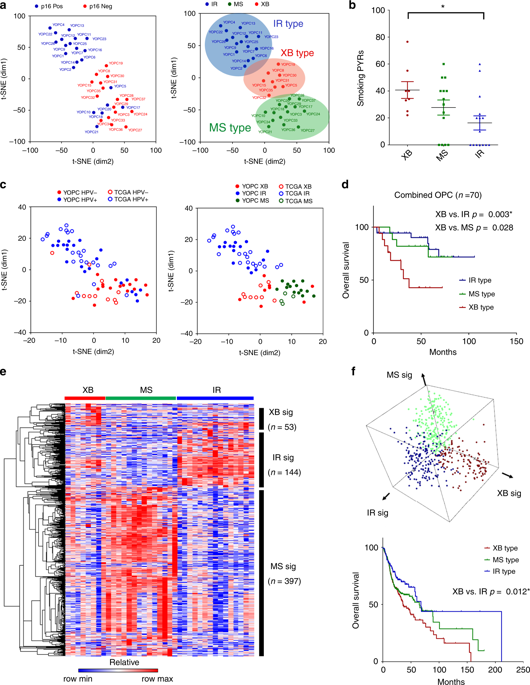British Journal of Cancer ( IF 6.4 ) Pub Date : 2020-04-01 , DOI: 10.1038/s41416-020-0796-8 Min Hwan Kim 1 , Jae-Hwan Kim 2 , Ji Min Lee 3 , Jae Woo Choi 2, 4 , Dongmin Jung 2 , Hojin Cho 5 , Hyundeok Kang 6 , Min Hee Hong 1 , Su Jin Heo 1 , Se Heon Kim 7 , Eun Chang Choi 7 , Da Hee Kim 7 , Young Min Park 7 , Sangwoo Kim 6 , Sun Och Yoon 8 , Yoon Woo Koh 7 , Byoung Chul Cho 1 , Hye Ryun Kim 1

|
Background
Oropharyngeal cancer (OPC) exhibits diverse immunological properties; however, their implications for immunotherapy are unknown.
Methods
We analysed 37 surgically resected and nine recurrent or metastatic anti-programmed death-1 (PD-1)/programmed death-ligand 1 (PD-L1)-treated OPC tumours. OPCs were classified into immune-rich (IR), mesenchymal (MS) and xenobiotic (XB) subtypes based on RNA-sequencing data.
Results
All IR type tumours were human papillomavirus (HPV) positive, most XB types were HPV negative, and MS types showed mixed HPV status. The IR type showed an enriched T cell exhaustion signature with PD-1+ CD8+ T cells and type I macrophages infiltrating the tumour nest on multiplex immunohistochemistry. The MS type showed an exclusion of CD8+ T cells from the tumour nest and high MS and tumour growth factor-β signatures. The XB type showed scant CD8+ T cell infiltration and focal CD73 expression. The IR type was associated with a favourable response signature during anti-PD-1/PD-L1 therapy and showed a high APOBEC mutation signature, whereas the MS and XB types showed resistance signature upregulation. Among anti-PD-1/PD-L1-treated OPC patients, the IR type showed a favourable clinical response (3/4 patients), whereas the XB type showed early progression (3/3 patients).
Conclusion
Our analysis classified OPCs into three subtypes with distinct immune microenvironments that are potentially related to the response to anti-PD-1/PD-L1 therapy.
中文翻译:

口咽癌的分子亚型显示出与免疫检查点阻断反应相关的独特免疫微环境。
背景
口咽癌 (OPC) 表现出多种免疫学特性;然而,它们对免疫疗法的影响尚不清楚。
方法
我们分析了 37 例手术切除和 9 例复发或转移性抗程序性死亡 1 (PD-1)/程序性死亡配体 1 (PD-L1) 治疗的 OPC 肿瘤。基于 RNA 测序数据,OPCs 分为富含免疫 (IR)、间充质 (MS) 和异生 (XB) 亚型。
结果
所有 IR 型肿瘤均为人乳头瘤病毒 (HPV) 阳性,大多数 XB 型为 HPV 阴性,MS 型显示混合 HPV 状态。IR 型在多重免疫组织化学上显示出丰富的 T 细胞衰竭特征,其中 PD-1 + CD8 + T 细胞和 I 型巨噬细胞浸润肿瘤巢。MS 类型显示 CD8 + T 细胞从肿瘤巢中排除以及高 MS 和肿瘤生长因子-β 特征。XB型显示CD8 +不足T 细胞浸润和局灶性 CD73 表达。IR 类型与抗 PD-1/PD-L1 治疗期间的良好反应特征相关,并显示出高 APOBEC 突变特征,而 MS 和 XB 类型显示出耐药特征上调。在抗 PD-1/PD-L1 治疗的 OPC 患者中,IR 型显示出良好的临床反应(3/4 患者),而 XB 型显示早期进展(3/3 患者)。
结论
我们的分析将 OPC 分为三个亚型,它们具有不同的免疫微环境,可能与抗 PD-1/PD-L1 治疗的反应有关。











































 京公网安备 11010802027423号
京公网安备 11010802027423号